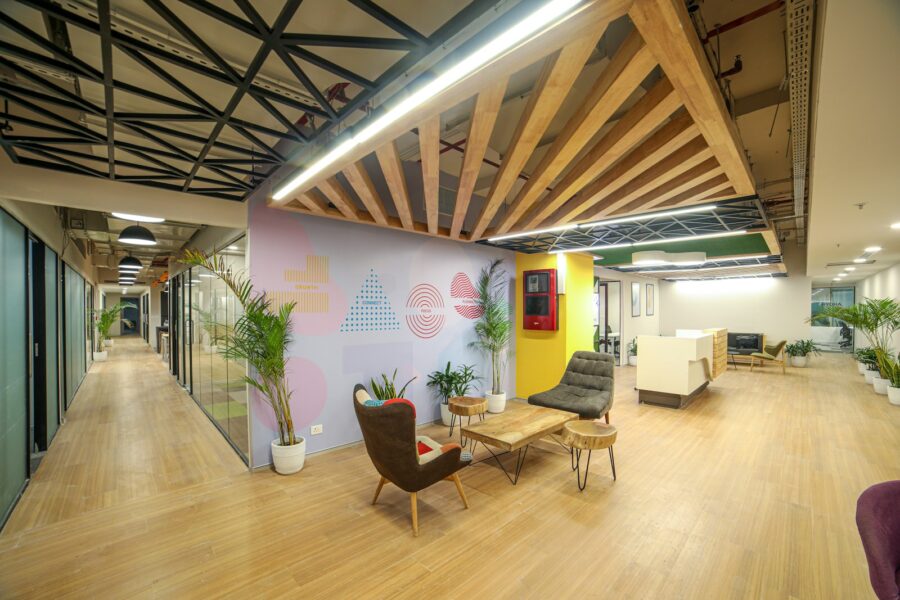In today’s rapidly evolving business landscape, fostering inclusivity in the workplace has become a top priority for all businesses. Here, we will go through the principles and strategies behind creating inclusive work environments that are neurodiversity friendly and meet the needs of a diverse workforce.
Understanding neurodiversity in the workplace
Neurodiversity refers to the wide range of neurological differences among individuals and covers a spectrum of conditions including autism, OCD, ADHD and dyslexia.
Embracing neurodiversity in the workplace and employing neurodivergent individuals not only promotes diversity and inclusion, but also unlocks the potential for innovation and creativity by introducing different perspectives and approaches to problem-solving and tasks.
With approximately 1 in 7 people in the UK being neurodiverse, businesses need to design offices that accommodate and celebrate this diversity. At EDB, we have seen an increasing demand for office designs that are tailored to meet the varying needs of a diverse workforce, support employee wellbeing and are adaptable for those who may struggle in a traditional workplace. While there isn’t a one-size-fits-all solution, there are several considerations when designing an office to support neurodiversity.
Design considerations for neurodiverse workforces
Consultation and collaboration
When designing for a diverse workforce, there is a wide spectrum of needs to consider, which is why the consultation phase with a fit out expert is key to determining what designs could benefit your team and future employees.
Many business owners have realised that if they’re trying to get more people back in the offices, they need to include their employees so that they feel like they have some ownership over the office. Therefore engaging with employees, including those who are neurodivergent, during the initial process is key for gathering insights and preferences. By involving diverse perspectives, organisations can ensure that the office environment meets the needs of all individuals.
Flexibility and variety
Recent studies have emphasised that employees tend to be more productive and satisfied when they have a variety of workspace types to choose from. Depending on the type of task they are engaged in, this is particularly common for those who are neurodivergent.
Having different spaces with different purposes is key for businesses that want to improve their office design for neurodiversity. Therefore you need to create a variety of workspace options to accommodate different work styles and preferences. This may include open spaces for socialising and collaboration, booths or quiet private rooms for focused work and intense concentration, breakout areas to relax, and soundproof meeting rooms where personal conversations can be had in confidence.
Layout and wayfinding
Office layout is also key when designing for neurodiversity and needs to be intuitive and easy to navigate for all individuals. Use visual and environmental cues such as plants, clear signage and consistent pathways to help improve wayfinding in your office, instead of creating spaces that all look the same which can cause difficulty.
Colour theory
Colour is a powerful communication tool and can influence mood and impact performance. But exposure to colour can also have a physical impact on us. Bright or full-intensity colours can overwhelm those who are neurodivergent and it can lead to a sensory overload. Instead, use neutral or warm colours like orange which help to increase engagement along with keeping employees calm and relaxed.
Sensory-friendly design
Lighting is another important consideration when designing for neurodiversity, as harsh lighting can cause agitation, anxiety, and visual fatigue, potentially limiting the ability to engage with spaces and activities fully. Choosing warm, soft, LED lighting with adjustable settings is essential when designing for neurodiversity and can have a wider benefit to all staff.
Natural lighting allows employees to connect with nature and reduces eye strain. Opening up the shades or installing more windows will make your office a more productive workspace.
Reducing noise levels
Excess noise can often add to a neurodivergent person’s already heightened levels of stress and anxiety. Acoustic design can help to reduce worry and tension by creating a calm and soothing environment.
Acoustic panels are an ideal feature to add to your office as they absorb sound waves, reducing the overall noise levels in the office environment. This helps create a more peaceful and comfortable atmosphere, promoting concentration and productivity among employees. Acoustic panels also help create private zones within open-plan layouts by reducing sound transmission between adjacent workstations or meeting areas. This enhances confidentiality and minimises distractions, allowing employees to focus on their tasks without interruptions.
Designing a neurodiversity friendly office
Inclusive office design is a fundamental aspect of creating environments where all employees feel valued, respected, and empowered to do their best work. Additionally, employees in a diverse workplace tend to have better job satisfaction, promoting productivity, engagement, and staff retention. By embracing neurodiversity and incorporating inclusive design principles, businesses can prioritise diversity and inclusion in the workplace and foster a culture of belonging and innovation.

Jeni Wilkie
Jeni Wilkie is one of the directors at Eatock Design and Build which started in 2020. She has been at the heart of the interior industry for over 15 years, working across different sectors including hospitality, commercial and education.


